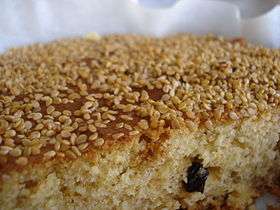Fanouropita
 | |
| Type | cake |
|---|---|
| Place of origin | Greece, Cyprus |
| Cooking time | 60 minutes |
| Main ingredients | flour |
| Similar dishes | vasilopita |
Fanouropita is a traditional sweet fasting pie of Greek cuisine. It is offered on the memory day of St. Fanourios on August 27, when the pie is given to believers as a blessing.[1] It is based on oils and does not contain any butter or eggs.[2] Believers seek to offer the cake and get "revelation" of objects or people in general, or to find something they are looking for.[1]
Etymology
The name comes from Saint Fanourios. Fanourios means the one who reveals (greek verb: "φαίνω").[3]
Origin
Worshiping Saint Fanourios while adopting the tradition of fanouropita origins either around 1500 AD or 1355-1369 AD, when the icon of Saint Fanourios was discovered, untouched, between ruins, in Rhodes or Cyprus.[1][4] Saint Fanourios, in local tradition of Orthodox people, is since then the revealer of lost objects.
Description
Fanouropita is usually round with diameter of about 25-30 cm. It is puffy, oily, aromatic and sometimes powdered with sifted white sugar.[5]
Ingredients
Ingredients are numbered traditionally to be a single number, seven, nine or eleven materials, the number varying by region. In its simplest version, fanouropita has only 7 materials, as many as the mysteries of the Orthodox Church.[6] The ingredients must be all intact, so it does not contain olive oil but vegetable oil. The basic / most common ingredients are: flour, vegetable oil, sugar, orange juice, baking powder, nuts, raisins. Other materials may include cinnamon, carnation, soda and water.[6]
Preparation
The solid ingredients are mixed together. The liquid ingredients are also mixed together, separetely form the solid ones. Afterwards the two mixes are mixed together in a round baking pan, which is put in the oven, at about 170-180 Celsious, for about an hour. After it is out of the oven it is left to cool down and then it is powdered with sifted sugar.[7]
Tradition
Fanouropita is blessed in church and its pieces are offered to people.[3] According to tradition, it is offered for the forgiveness of the Saint Fanourios' mother, who was a sinful woman behaving very cruely to the poor.[1]
In popular culture
In various areas of Greece and Cyprus the tradition of the custom of the cace is followed by some Orthodox Christians to ask Saint Fanourios "reveal" a job to unemployed or an item that was lost or a lost case, to give health and find a groom for unmarried girls.[1][8]
See also
References
- 1 2 3 4 5 "Φανουρόπιτα: Συνταγές και το έθιμο". Madata.GR (in Greek). 2012-08-26. Retrieved 2018-05-28.
- ↑ "Fanouropita~Φανουρόπιτα". www.gourmelita.com. Retrieved 2018-05-28.
- 1 2 "Φανουρόπιτα: Πώς τη φτιάχνουμε και τι συμβολίζει". Arcadia Portal (in Greek). 2017-08-26. Retrieved 2018-05-28.
- ↑ "Saint Fanourios". Pantokratoras. Retrieved 2018-05-28.
- ↑ "Φανουρόπιτα καλοφάγωτη, για «να φανερωθεί η τύχη σας!»". LiFO. Retrieved 2018-05-28.
- 1 2 ""Άγιε μου Φανούριε, φανέρωσέ το" - Η παράδοση και τα έθιμα για τη φανουρόπιτα | ekriti". ekriti. 2017-08-26. Retrieved 2018-05-28.
- ↑ iefimerida.gr (2016-08-27). "Γιατί σήμερα φτιάχνουν Φανουρόπιτες -Τι συμβολίζουν". iefimerida.gr (in Greek). Retrieved 2018-05-30.
- ↑ eleni (2017-08-23). "Φανουρόπιτα: Τι συμβολίζει, πότε και γιατί την φτιάχνουμε". Συνταγες μαγειρικής (in Greek). Retrieved 2018-05-28.